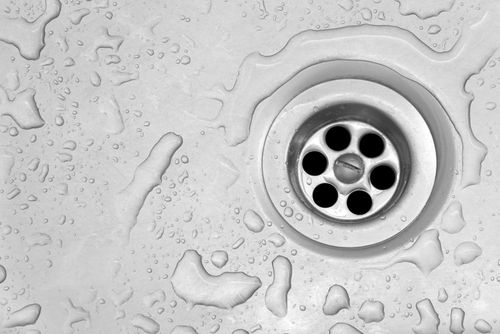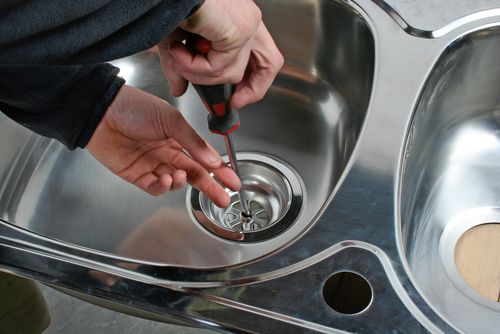Drain cleaning might not be at the top of your chore list, but it is something you need to take care of from time to time. Think about some of the things that go down your drain. If you think there’s just water going down there, think again! Everything from grease and tomato sauce to makeup and hairspray gets washed down the drain. The end result may be disgusting odors that won’t go away. When food sticks to the inside of drains, it continues to decay. If you’ve tried to get rid of it, you might think there’s nothing to make it go away.
Sometimes grease and food build-up over time, slowly creating clogs. By the time a clog stops letting water drain, it can be a really big problem. The best defense against clogs is to prevent them from happening in the first place. After they happen, it may take a little more effort to get your drains fresh and working again. These tips on drain cleaning can help prevent you from needing a plumber.

1. All-Natural Drain Rinse
Vinegar and baking soda have a super cleaning power without the chemicals that can harm you or your plumbing. It’s safe enough to use regularly to keep drains clean and odor-free. Pour ½ cup of baking soda down the drain. Add ½ cup of white vinegar immediately behind it. Cover the drain and let the mixture work for fifteen or twenty minutes. Meanwhile, boil a kettle of water. Once the time is up, pour the water down the drain.
For stains and mineral deposits around the outside of the drain, mix equal parts of baking soda and white vinegar to make a paste. Apply to the entire area and let it sit. Use a soft brush to remove the buildup and rinse.
2. Treat with Enzymes
Enzymes naturally dissolve bacteria, mold, and all kinds of build-up. The natural ingredients aren’t harmful to your plumbing or your septic system. Unlike chemical clog removers or drain cleaners, they’re also environmentally safe. One of the drawbacks to these products is that they take longer to work. A simple solution is to put ‘drain sticks’ in your drains once a month to keep the action going. Make sure you choose the kind that only contains environmentally-friendly ingredients.
3. Get Your Disposal Lemony Clean
Trash disposals pose special problems when trying to get the dirt and grime out. To create an all-natural abrasive that scours the parts of your disposal you can’t reach, pour a few cups of ice cubes, a few lemon peels, and a handful of course salt into the disposal. Turn on the disposal and let it do the grinding to clean residue away.

Once a Clog Happens
Suddenly, and at the worst possible time, the water stops draining out of your sink. There’s a clog and nothing is getting through. It’s always a good idea to know how to handle the situation before it happens. You may be able to get rid of the clog without calling a plumber. Have the tools you require on-hand so you don’t have to go out for them when you need them.
All clogs are not the same. Those you have in the kitchen are more likely to be greasy clogs that have built up over time. In the bathroom, hair is a more likely culprit. The way we use our plumbing system is what causes clogs to form the way they do. To try and dislodge a clog, you can start with the same basic techniques for any room in your house, but, keep in mind, the method that works best once might not work at all the next time around.
– Start with a Plunger
Buy bellows-style plungers and get a separate one for the toilet. These ‘accordion-style’ plungers are easier to use and they create a better seal for more effective plunging. If you’re working on a double-sink, close off one of the drains before starting.
– Melt Greasy Clogs
Wrap a heating pad around the trap pipe beneath the sink. While the heating pad heats up the pipe beneath, run hot water through the drain. The grease should turn to liquid when it reaches the right temperature.
– Blast the Clog Out
You may have to go to the hardware store to find one of the gas or water powered cleaners that are made to blast clogs out of the drain. They either use compressed air or gas to apply pressure. If you use one that is gas-powered, make sure it fits your drain snugly. Without a tight seal, the pressure could come back on you.
If you use a water-based drain cleaning product, you’ll probably have to hook it to a water hose. Either type of product can be fitted with an adaptor to create a better seal or to attach to an indoor faucet.
– Let Nature Take Its Course
Avoid the urge to use drain cleaners that have words like “Fire” or “Devil” in their name. These harsh chemicals are dangerous to you and your pipes. In spite of their strength, they don’t usually work. Instead, use enzymes or a bacterial drain cleaner overnight. This gives them time to work their magic without the use of harmful chemicals.
– Snare the Hair
Depending on how your sink is designed, this might or might not be a good solution for you. There are small, barbed plastic tools that are made to pull hair out of your drains. Most often, clogs in the bathroom sink are mostly hair. This is where most people brush and style their hair and shave, letting pieces of hair wash down the sink. If the barbed tool will fit into your drain, it will grab the hair and pull it right back out.
– Snake Out Deep Clogs
A drain snake, or auger, is made for drain cleaning deep inside your pipes. You can purchase one at the hardware store in any of several different lengths. A 25-foot snake is usually ideal for most clogs. If you’ve already put harsh drain cleaners down your pipes, protect your hands and eyes while you work. These chemicals are highly abrasive to your skin and eyes.
You might need to remove the trap under the sink. This is the j-shaped pipe underneath. Use a pair of pliers if necessary. Place a bucket underneath to catch any trapped water. Feed the snake into the drain, turning the handle to rotate it as you go. You’ll know you’ve reached the clog when the snake will no longer feed. Turn the handle or crank so that the snake rotates firmly inside the pipe. The motion forces the hook on the far end to break up the clog. You should feel the clog give way. When you pull the snake out of the drain, the crud and build-up from the clog will be all over the coil on the end. Clean it off and dispose of the crease in the trash.
You may need to repeat the process a few times to completely clean the drain. It’s possible that you have more than one clog or the beginning of another one. Once the snake feeds easily through the drain, replace the trap cover. Turn on the water to make sure the drain is clear.

How to Prevent New Clogs
It’s hard to say whether drains are more likely to get clogged with or without a trash disposal. You may pour a lot more stuff down your kitchen sink than you realize. All of us are guilty of letting things slide from time to time. We also tend to think of a garbage disposal as being unbreakable. The fact is, there are some things that even those steel blades can’t handle.
That’s why the first step in preventing clogs is to not put anything down your drains that will clog. That includes any amount of grease. It isn’t enough to pour liquid grease into the trash. Use a paper towel to wipe out what’s left behind in the skillet. Otherwise, it goes down your drain and sticks to the pipes.
Coffee grounds are another no-no. They’re typically used and wet when they get washed down the drain. That makes them heavy and lets them stick to the pipes or the grease and other residues that are already there.
Pasta is another problem that many people aren’t aware of. When it gets wet, it forms a pasty-substance that can stick to your pipes like glue. To prevent losing pasta or any of these things down the drain, keep a drain screen in place.
Blue Dawn dishwashing liquid is one of the best drain cleaning tools for greasy kitchen sinks. Pour some of the liquid into your drain and follow with hot water. Used as regular maintenance, the cleaner can help prevent greasy clogs from forming.
Drain screens help in the bathroom, too. Remove bits of hair from the sink after shaving and keep the screen cleaned out in the bathtub. Use enzymes or bio cleaners to keep bathroom drains clean from things like skin cells and toothpaste. Anything that goes through the drains other than water can build up as residue over time.
